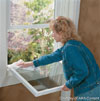Lady PP' Heart of the Home
|
 Do an Annual Walk-around Home Check, and Donít Forget the Windows and Doors(ARA) - Your home -- like your body and your car -- needs a regular checkup to run smoothly. An annual, fall walk-around home check is a great way to find any potential maintenance issues before winter arrives. ďIt is important to periodically monitor the overall condition of a home,Ē says John Ghent, president of the American Society of Home Inspectors, a non-profit professional organization for home inspectors. ďSimple wear and tear from weather and age occurs in every home. It is wise to fix any problems before they lead to extensive and costly repairs.Ē Your inspection should include all of the major systems that protect your home, including the windows, doors, roof, gutters, exterior finish, foundation, and steps; plus the interior systems such as heating, cooling, chimney, and electrical, says Pella Corporationís Gary Mathes, manager, residential architectural services. Look for obvious signs of deterioration, damage or potential problems. Check for conditions that may allow moisture to enter your home -- from plants and sprinkler systems too close to the house to low-lying areas that direct water toward the home. Likewise, watch for any deteriorating wood, cracks, damaged caulk, old weather stripping, and other potential sources of leaks, says Mathes. The following 10 items cover common maintenance issues with windows and doors and should be included in your walk-around check: 1. Inspect the interior and exterior finishes around windows and doors. Is the paint or stain in good condition? Signs of flaking and peeling may mean that itís time to refinish the unit. 2. Look closely at all exterior surfaces for cracking, deteriorated wood and other damage that might be caused by condensation or other water penetration. Are any interior surfaces such as walls, floors or ceilings discolored or showing the effects of moisture? 3. If you spot a problem, try to find its source. For example, discolored wood around a window might actually be caused by moisture entering the house some distance away. With a roof leak, for example, it is not uncommon for water to run down the inside of the wall and show up at the window. Contact an expert to obtain help if needed. 4. Check window sills and tracks for dirt and other debris such as sand, leaves, insects, and pine needles. Open the windows and clean out the area with a soft brush. Do the same for sliding patio doors. Debris can hamper the air-tight effectiveness and overall performance of doors and windows. 5. Feel for uneven sliding and sticking when you open and close a window or door. If windows or doors stick, try using a non-oily lubricant on the opposing finishes, such as Paraffin wax, which does not attract as much dust and grime. 6. Look at the weather stripping around all doors and windows. Re-attach any loose portions and replace portions that are ripped or torn. 7. Operate locking mechanisms and make adjustments if they feel loose or donít work smoothly. Locks not only help keep out potential intruders, but they hold doors and windows tightly in place to lock out rain, wind, snow, and insects. 8. Inspect any weep holes and breather holes if your windows or sliding patio doors have them. Weep holes allow excess moisture to escape and breather holes allow air exchange within certain components. Clear blocked holes with a small wire, toothpick or similar device, being careful not to expand the holes. 9. Check all exterior sealants and caulking on and around all windows and doors. Pay particular attention to areas susceptible to punishment from rain, water and extreme sunlight. Remove damaged material and reapply sealant. 10. In coastal locations, rinse all exterior metal components and cladding to minimize the corrosive effects of salt spray and fog damage. This should be done at least quarterly. More importantly, routine maintenance checks could safeguard your family by ensuring that your doors and windows operate properly, the primary and secondary means of escape in the event of fire. In addition to doing a walk-around check of your home, test your smoke detectors and change the batteries every fall so your family will quickly be alerted in the event of a fire. Schedule regular family fire drills at least twice a year. Log on to www.pella.com/about/fire.asp to download and print a fire escape grid to help develop and practice a fire escape plan for your family. For more information about replacing windows and doors for better performance and a more beautiful home, contact your local Pella expert. To learn more, call 888-84-PELLA or log on to www.pella.com/finder. Courtesy of ARA Content
Please post your comments on this article or ideas you have for home decorating on the Home Organization Message Board These articles are for informational purposes only. The authors have provided these projects in good faith;
however, results cannot be guaranteed. Follow instructions carefully and use caution and common sense. If you
have any questions, get them answered before proceeding. Read and follow instruction's on product labels. Make
safety a priority. Store supplies in a secure place.
Lady PP's Heart of the Home will assume no liability related to the use or misuse of the information contained here. Lady PP's Heart of the Home is seeking do-it-yourself and craft projects. If you have a project you would like to submit, please contact us: E-mail . No right click ResourcesLinks are provided for your information and enjoyment. The links do not imply endorsement of the sites' products or advice.Web News & Articles(About Resources on the Internet)About Guide:Family Crafts About Guide:Home Repairs |